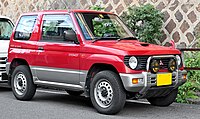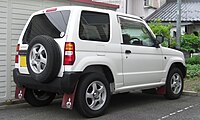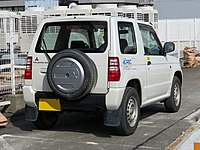Mitsubishi Pajero Mini
| Mitsubishi Pajero Mini | |
|---|---|
Kurashiki, Okayama (Mizushima plant) | |
| Body and chassis | |
| Class | Kei car |
| Body style | 3-door SUV |
| Layout | |
| Chronology | |
| Successor | Mitsubishi eK X |
The Mitsubishi Pajero Mini (Japanese: 三菱・パジェロミニ, Hepburn: Mitsubishi Pajero Mini) is a kei car produced by Mitsubishi Motors from December 1994 until June 2012.
Overview
Based on the platform of the
Compared to the full-sized original, the kei vehicle was considerably smaller and was fitted with petrol 660 cc four-cylinder engines.The popularity of the vehicle inspired Mitsubishi to create several limited editions, including the "Iron Cross", "Desert Cruiser", "White Skipper" and "Duke".
First generation (1994; H51/56A)
| Mitsubishi Pajero Mini H51A/H56A | ||
|---|---|---|
Curb weight | 780–930 kg (1,720–2,050 lb) | |
The original Pajero Mini was first presented in December 1994. It was available with a choice of
In May 1996 the Pajero Mini "Skipper", a special version for urban and town use, was released. The name is a reference to Mitsubishi's
-
Rear view
-
Pajero Mini VR-II (turbo); this model is easily recognized by its hood scoop
-
Interior (XR-II)
-
A Pajero Mini Duke X-I
Second generation (1998; H53/58A)
| Mitsubishi Pajero Mini H53A/H58A | ||
|---|---|---|
Curb weight | 820–990 kg (1,808–2,183 lb) | |
In October 1998 the kei car regulations were again updated, and the Pajero Mini was widened and lengthened accordingly at the same time.[2] The "Duke" special model was carried over; it now received a larger, deeper set grille with vertical rather than horizontal bars.
In Japan, the Pajero Mini was sold at a specific retail chain called
Production of the Mitsubishi Pajero Mini ended in June 2012.[4]
-
Mitsubishi Pajero Mini Right Front
-
Mitsubishi Pajero Mini Right Back
-
Mitsubishi Pajero Mini Right Front
-
Mitsubishi Pajero Mini Left Front
-
A Pajero Mini Duke
-
NISSAN KIX
-
NISSAN KIX RS
-
Mitsubishi Pajero Mini last model
Annual production and sales
| Year | Production | Sales | Exports |
|---|---|---|---|
| 1994 | unknown | unknown | unknown |
| 1995 | 104,990 | unknown | unknown |
| 1996 | 71,185 | unknown | unknown |
| 1997 | 43,302 | 44,224 | 358 |
| 1998 | 48,792 | 47,592 | 32 |
| 1999 | 36,580 | 35,673 | 3 |
| 2000 | 24,895 | 27,011 | 2 |
| 2001 | 16,590 | 17,458 | 0 |
| 2002 | 12,672 | 13,720 | – |
| 2003 | 17,141 | 17,237 | – |
| 2004 | 10,307 | 10,371 | – |
| 2005 | 10,445 | 10,611 | – |
| 2006 | 9,436 | 9,367 | – |
| 2007 | 9,279 | 9,195 | – |
| 2008 | 17,033 | 11,456 | – |
| 2009 | 11,195 | 8,646 | – |
| 2010 | 9,165 | 8,056 | – |
| 2011 | 9,681 | 8,281 | – |
| 2012 | 5,862 | 6,081 | – |
| 32 more cars sold 2013-2017 |
(Sources: Facts & Figures 2000, Facts & Figures 2001, Facts & Figures 2005, Facts & Figures 2009, Mitsubishi Motors website)
References
- ^ "Mitsubishi Motors Corporation", Fundinguniverse.com
- ^ "Toppo BJ, Minica, Pajero Mini; New regulation mini-cars from Mitsubishi Motors" Archived 2009-07-16 at the Wayback Machine, Mitsubishi Motors press release, October 5, 1998
- ^ "Nissan Motor Company and Mitsubishi Motors to expand OEM supply agreement for mini-cars" Archived 2009-04-16 at the Wayback Machine, Mitsubishi Motors press release, February 27, 2008
- ^ "三菱自動車、軽乗用車 『パジェロミニ』 の特別仕様車「Premium Selection ~Final Anniversary~」を発売", Mitsubishi Motors press release
External links
- Pajero Mini (Japanese)
- Pajero Mini VR (4WD) specifications, Mitsubishi-motors.com












